-
 Bitcoin
Bitcoin $115800
-2.47% -
 Ethereum
Ethereum $3690
1.19% -
 XRP
XRP $3.105
-1.91% -
 Tether USDt
Tether USDt $0.9999
-0.07% -
 BNB
BNB $771.0
0.19% -
 Solana
Solana $179.9
-3.54% -
 USDC
USDC $0.9998
-0.03% -
 Dogecoin
Dogecoin $0.2291
-3.40% -
 TRON
TRON $0.3140
0.81% -
 Cardano
Cardano $0.8007
-1.24% -
 Hyperliquid
Hyperliquid $42.92
-0.44% -
 Stellar
Stellar $0.4212
-2.16% -
 Sui
Sui $3.730
0.03% -
 Chainlink
Chainlink $18.06
0.03% -
 Bitcoin Cash
Bitcoin Cash $546.6
5.08% -
 Hedera
Hedera $0.2438
0.55% -
 Avalanche
Avalanche $23.57
-0.81% -
 Litecoin
Litecoin $114.2
1.04% -
 UNUS SED LEO
UNUS SED LEO $8.970
-0.35% -
 Shiba Inu
Shiba Inu $0.00001363
-0.16% -
 Toncoin
Toncoin $3.136
-0.89% -
 Ethena USDe
Ethena USDe $1.001
-0.04% -
 Uniswap
Uniswap $10.30
1.42% -
 Polkadot
Polkadot $4.013
-0.06% -
 Monero
Monero $324.8
0.87% -
 Dai
Dai $0.9999
-0.04% -
 Bitget Token
Bitget Token $4.509
-1.38% -
 Pepe
Pepe $0.00001226
-2.60% -
 Aave
Aave $291.8
1.34% -
 Cronos
Cronos $0.1294
2.19%
How to judge the short-term top signal of the 30-minute RSI overbought + 15-minute hanging neck line?
A 30-minute RSI above 70 and a 15-minute hanging man candle suggest a high-probability short setup when confirmed by price action and volume.
Jul 24, 2025 at 01:29 pm
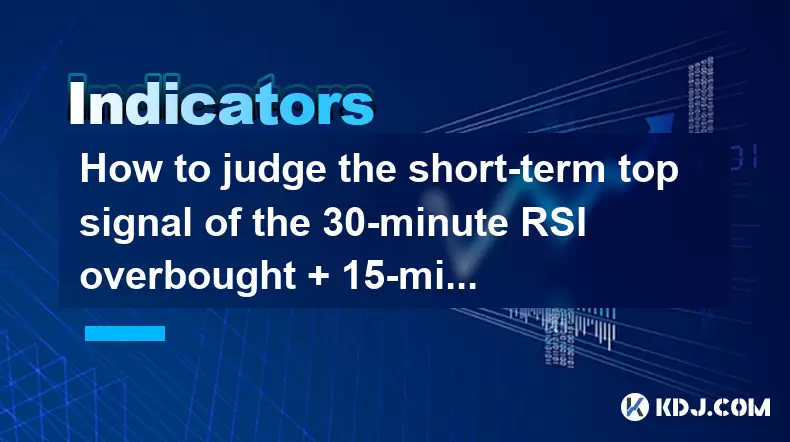
Understanding the 30-Minute RSI Overbought Condition
The Relative Strength Index (RSI) is a momentum oscillator that measures the speed and change of price movements. On a 30-minute chart, the RSI helps traders identify overbought or oversold conditions within short-term trading cycles. When the RSI value rises above 70, it is generally considered overbought, signaling that the asset may be overvalued and due for a pullback. However, overbought does not automatically mean a reversal will occur immediately. The key lies in confirming the signal with price action and other technical patterns.
To detect an overbought signal on the 30-minute RSI, traders should monitor the RSI line crossing above 70 and staying elevated for at least two consecutive candlesticks. This sustained overbought condition increases the likelihood of a correction. It's essential to use a standard 14-period RSI setting, as this is the most widely accepted configuration. Deviating from this may lead to false signals. When the RSI remains above 70 while the price continues to climb, it suggests weakening momentum despite higher prices — a potential divergence.
Identifying the 15-Minute Hanging Man Candlestick Pattern
The hanging man is a bearish reversal candlestick pattern that typically appears at the end of an uptrend. On a 15-minute chart, this pattern can provide early warnings of a short-term top, especially when aligned with other bearish indicators. The hanging man has a small real body, a long lower shadow (at least twice the length of the body), and little to no upper shadow. The color of the body is less important, though a red (bearish) body increases the strength of the signal.
To confirm a valid hanging man:
- The pattern must appear after a clear upward price movement.
- The long lower shadow indicates that sellers pushed the price down significantly during the session, but buyers managed to push it back up.
- The closing price should be near the opening price, showing indecision and potential exhaustion of buyers.
Traders should wait for the next candle to close below the hanging man’s closing price to confirm the bearish reversal. This follow-through is crucial, as a single candle is not sufficient to predict a trend change.
Combining 30-Minute RSI Overbought with 15-Minute Hanging Man
When both the 30-minute RSI is overbought and a 15-minute hanging man appears, the confluence increases the probability of a short-term top. This multi-timeframe analysis allows traders to align momentum indicators with price action for higher-accuracy entries. The 30-minute RSI provides the broader context of overbought conditions, while the 15-minute hanging man offers precise timing for potential reversal.
To apply this strategy:
- Monitor the 30-minute chart for RSI crossing above 70 and staying elevated.
- Switch to the 15-minute chart and look for a hanging man candle forming near the same time.
- Ensure that the hanging man occurs after at least three consecutive green candles to confirm an existing uptrend.
- Check for volume: a spike in volume during the hanging man formation strengthens the reversal signal.
This dual confirmation reduces false positives. For example, an overbought RSI alone might lead to premature shorting if the trend remains strong. Adding the hanging man pattern ensures that price action supports the bearish momentum shift.
Executing a Short Entry Based on the Signal
Once both conditions are met, traders can consider entering a short position. The exact execution requires precise steps to manage risk and maximize reward.
- Wait for the 15-minute candle following the hanging man to close below the hanging man’s close.
- Enter the short position at the open of the next candle.
- Place a stop-loss just above the high of the hanging man candle to limit downside risk if the price continues upward.
- Set a take-profit level at the nearest support zone, such as a previous swing low or a Fibonacci retracement level (e.g., 50% or 61.8%).
For example, if the hanging man forms at $30,000 on Bitcoin and the next candle closes at $29,800, enter short at $29,800. Set a stop-loss at $30,100 (above the hanging man’s high) and target $29,200 (near a known support level). This gives a risk-reward ratio of at least 1:2, which is favorable.
Using limit orders instead of market orders helps avoid slippage, especially in volatile crypto markets. Traders can also scale out of the position by taking partial profits at multiple levels.
Filtering False Signals and Managing Risk
Not every overbought RSI and hanging man combination results in a successful reversal. Several factors can generate false signals, and traders must apply filters to improve accuracy.
- Avoid trading during major news events or high-impact announcements, as price may ignore technical patterns.
- Check the overall trend on the 4-hour or daily chart — shorting in a strong bull market increases risk.
- Look for bearish divergence on the 30-minute RSI: if price makes a higher high but RSI makes a lower high, the reversal signal is stronger.
- Use volume analysis — declining volume during the uptrend followed by a spike on the hanging man supports the reversal.
Risk management is critical. Never risk more than 1-2% of your trading capital on a single trade. Use position sizing to adjust the number of contracts or coins based on stop-loss distance. For instance, if your account is $10,000 and you risk 1%, your maximum loss is $100. If the stop-loss is 200 pips away, calculate the appropriate lot size accordingly.
Frequently Asked Questions
Can the hanging man pattern appear in a downtrend?
Yes, the hanging man can appear in a downtrend, but it is not considered a reliable reversal signal in that context. When it forms during a downtrend, it may indicate temporary support, but without an established uptrend, it lacks the necessary bullish momentum to qualify as a valid hanging man. The pattern is only meaningful when it appears after a clear upward price movement.
What if the 30-minute RSI is over 70 but the 15-minute chart shows a bullish engulfing candle instead?
This creates a conflicting signal. A bullish engulfing candle contradicts the bearish hanging man and suggests strong buying pressure. In such cases, the bullish pattern takes precedence, and the overbought RSI may indicate continuation rather than reversal, especially in strong trends. Traders should avoid shorting and wait for clearer confirmation.
Is the 14-period RSI the only setting that works for this strategy?
While the 14-period RSI is standard, some traders adjust it to 9 or 11 for more sensitivity. However, shorter periods increase false signals. Using 14 ensures stability and is widely followed by institutional and retail traders, making it a self-fulfilling indicator. Deviating from it may reduce the strategy’s effectiveness.
How long should I hold the short position after entry?
Hold the position until the take-profit level is reached or the price action shows signs of reversal, such as a bullish engulfing candle or RSI dropping below 30 (oversold). Do not hold beyond the initial target unless new bearish signals emerge. Time-based exits (e.g., 6 hours) can also be used if price stalls near support.
Disclaimer:info@kdj.com
The information provided is not trading advice. kdj.com does not assume any responsibility for any investments made based on the information provided in this article. Cryptocurrencies are highly volatile and it is highly recommended that you invest with caution after thorough research!
If you believe that the content used on this website infringes your copyright, please contact us immediately (info@kdj.com) and we will delete it promptly.
- Kiyosaki's Crypto Playbook: Ditching Paper for Real Assets Like Bitcoin
- 2025-07-25 22:30:11
- Satoshi-Era Whales Stir the Bitcoin Pot: What's the Deal?
- 2025-07-25 22:30:12
- Pi Coin Value in Indian Rupees (INR) 2024: Decoding the Hype
- 2025-07-25 21:45:50
- Crypto Investing: Top Picks and Meme Coin Mania in '25
- 2025-07-25 21:52:07
- Ark Invest's Portfolio Rebalance: Coinbase, Block, and the Crypto Shift
- 2025-07-25 21:52:07
- Bitcoin's Wild Ride: Sell-offs, Volatility, and What's Next
- 2025-07-25 21:55:18
Related knowledge

How to interpret that the KDJ D line is downward for a long time but the price is sideways?
Jul 25,2025 at 07:00pm
Understanding the KDJ Indicator and Its ComponentsThe KDJ indicator is a momentum oscillator widely used in cryptocurrency trading to assess overbough...

What does it mean that the KDJ indicator forms a double bottom at a low level?
Jul 25,2025 at 05:08pm
Understanding the KDJ Indicator in Cryptocurrency TradingThe KDJ indicator is a momentum oscillator widely used in cryptocurrency trading to identify ...
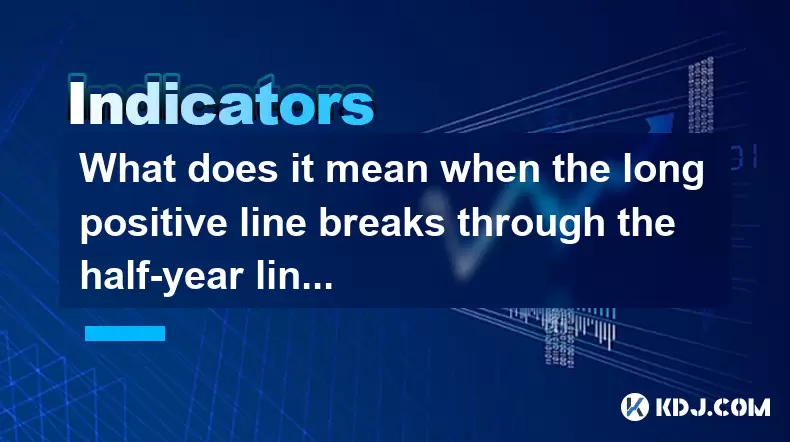
What does it mean when the long positive line breaks through the half-year line and then steps back?
Jul 25,2025 at 06:49pm
Understanding the Long Positive Line in Candlestick ChartsIn the world of cryptocurrency trading, candlestick patterns play a vital role in technical ...
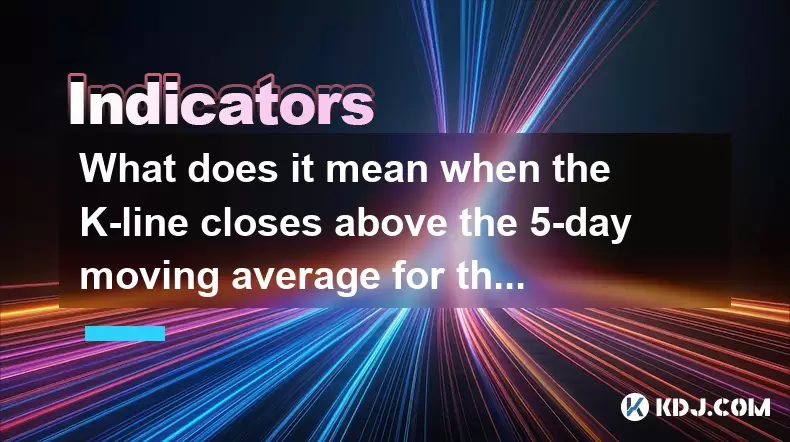
What does it mean when the K-line closes above the 5-day moving average for three consecutive days?
Jul 25,2025 at 10:07pm
Understanding the K-line and 5-day Moving AverageThe K-line, also known as a candlestick, is a critical charting tool used in technical analysis to re...
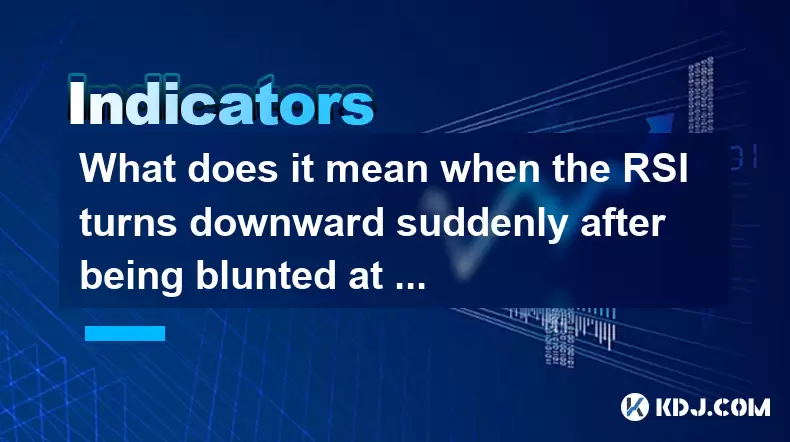
What does it mean when the RSI turns downward suddenly after being blunted at a high level?
Jul 25,2025 at 04:00pm
Understanding the RSI and Its Role in Technical AnalysisThe Relative Strength Index (RSI) is a momentum oscillator that measures the speed and change ...
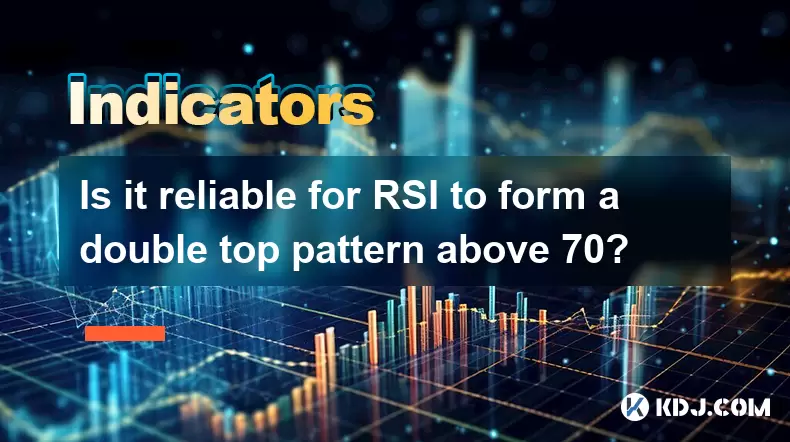
Is it reliable for RSI to form a double top pattern above 70?
Jul 25,2025 at 04:49pm
Understanding the RSI Indicator and Its Role in Technical AnalysisThe Relative Strength Index (RSI) is a momentum oscillator that measures the speed a...

How to interpret that the KDJ D line is downward for a long time but the price is sideways?
Jul 25,2025 at 07:00pm
Understanding the KDJ Indicator and Its ComponentsThe KDJ indicator is a momentum oscillator widely used in cryptocurrency trading to assess overbough...

What does it mean that the KDJ indicator forms a double bottom at a low level?
Jul 25,2025 at 05:08pm
Understanding the KDJ Indicator in Cryptocurrency TradingThe KDJ indicator is a momentum oscillator widely used in cryptocurrency trading to identify ...

What does it mean when the long positive line breaks through the half-year line and then steps back?
Jul 25,2025 at 06:49pm
Understanding the Long Positive Line in Candlestick ChartsIn the world of cryptocurrency trading, candlestick patterns play a vital role in technical ...

What does it mean when the K-line closes above the 5-day moving average for three consecutive days?
Jul 25,2025 at 10:07pm
Understanding the K-line and 5-day Moving AverageThe K-line, also known as a candlestick, is a critical charting tool used in technical analysis to re...

What does it mean when the RSI turns downward suddenly after being blunted at a high level?
Jul 25,2025 at 04:00pm
Understanding the RSI and Its Role in Technical AnalysisThe Relative Strength Index (RSI) is a momentum oscillator that measures the speed and change ...

Is it reliable for RSI to form a double top pattern above 70?
Jul 25,2025 at 04:49pm
Understanding the RSI Indicator and Its Role in Technical AnalysisThe Relative Strength Index (RSI) is a momentum oscillator that measures the speed a...
See all articles

























































































